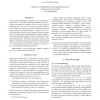Free Online Productivity Tools
i2Speak
i2Symbol
i2OCR
iTex2Img
iWeb2Print
iWeb2Shot
i2Type
iPdf2Split
iPdf2Merge
i2Bopomofo
i2Arabic
i2Style
i2Image
i2PDF
iLatex2Rtf
Sci2ools
ICIP
2009
IEEE
2009
IEEE
Adaptivity And Group Invariance In Mathematical Morphology
The standard morphological operators are (i) defined on Euclidean space, (ii) based on structuring elements, and (iii) invariant with respect to translation. There are several ways to generalise this. One way is to make the operators adaptive by letting the size or shape of structuring elements depend on image location or on image features. Another one is to extend translation invariance to more general invariance groups, where the shape of the structuring element spatially adapts in such a way that global group invariance is maintained. We review group-invariant morphology, discuss the relations with adaptive morphology, point out some pitfalls, and show that there is no inherent incompatibility between a spatially adaptive structuring element and global translation invariance of the corresponding morphological operators.
| Added | 10 Nov 2009 |
| Updated | 21 Dec 2009 |
| Type | Conference |
| Year | 2009 |
| Where | ICIP |
Comments (0)

